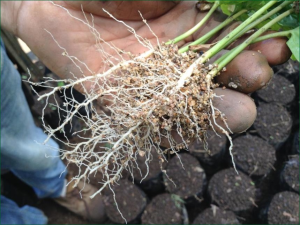This is a guest post by Hannah Francis, a Fulbright Scholar working with CRS’ Blue Harvest team in El Salvador this year. Hannah is a soil scientist helping analyze research data from hundreds of coffee farms. This post builds on our recent post called Get Me SOM, and several other posts on soil management on coffee farms.
Guest Post: Hannah Francis
CEC is a measurement of soil health, or fertility. Technically, CEC is the electrostatic interaction between the negatively charged surfaces of organic colloids or clay particles and the positively charged ions, or cations, in soils.
Wait! I know the technical lingo can be a bit intimidating, but don’t click away. In the next 800 words, you’ll have great capacity to understand cation exchange! We are breaking this down word by word:
First, CATION
An ion is a molecule, and a cation is a molecule with a positive charge. Many cations, such as potassium, magnesium, and calcium are important nutrients for plants. Cations are expressed as abbreviations with their corresponding charges. For example: Calcium (Ca2+), magnesium (Mg2+), and potassium (K+).
Cations (nutrients) occur naturally through the weathering of minerals in soils (soils rock!). They can also be added to soils through soil amendments and fertilizers.
Second, EXCHANGE
Cations stick to surfaces that are negatively charged. (Positive things like negative things).
- The edges of plant roots generate a negative charge (for reasons described below).
- Soil Organic Matter (SOM) has a negative surface charge as part of its organic chemistry.
- Also, the structure of clay minerals yields a negative surface charge (through a process called isomorphic substitution—read more here).
These negative sites on root edges, SOM, and clay minerals all create CATION EXCHANGE SITES.
Soil moisture is key for helping cation exchange; when soils are moist, some cations stick to those exchange sites, and some cations are able to float and move “in solution”.
In order for plant to attract nutrients (cations) that are floating in solution, or attached to SOM and clay, roots excrete hydrogen molecules, and the hydrogen (with a +1 charge) will “bump off” other cations, thereby making these cations (nutrients) available to the exchange sites on the root. This process is called cation exchange. (See here for a professor with a pocket protector describing cation exchange with cheesy graphics).
Third, CAPACITY
The “capacity” part is the total amount of cations that a soil can hold. The more cations a soil can hold, the more fertile the soil (sort of).
The “capacity” is dependent (mainly) on a three key properties, including: (1) texture – how much clay a soil has; (2) SOM content; and (3) the acidity of soil.
Note on pH: Soil acidity is a measure of the concentration of H+ cations in a soil solution, an acidic soil is one with high concentration of H+. (This is measured as pH on a scale where “7” is neutral. Low pH = high acidity, just to confuse us all). Too much H+ makes it hard for roots to attract other cations (nutrients) because H+ cations overwhelm the cation exchange sites. We’ll address what to do if your exchange sites have too much H+ below.
CEC is measured in soil laboratories, and is expressed in miliequivalence per 100g (meq/100g). These units are a measurement of the concentration of cations on the exchange sites, taking into account their charge per weight of sample. A very low CEC means that the soil has low capacity to hold nutrients. Generally, CEC values at or above 10-20cmolc/kg are better for farming. (I am over-simplifying a bit here, because what matters is not so much the CEC value, but what cations (nutrients) are on those exchange sites).
Ok, now you’re basically a CEC savant! A soil chemist! All it took was getting a little “soiled” with terminology.
Now, why does all this matter?
Managing CEC.
One way to increase soil fertility is to increase CEC. The better the CEC, the easier it is for roots to pull nutrients from the soil. Where soils are low in clay content (sandy or loamy soils), CEC tends to be low. Also, where SOM is low, CEC is low. Since it’s not possible to change soil texture (it’s not practical to add more clay), a farmer’s primary solution to increase soil fertility is to increase SOM. (See this post for how to increase SOM).
Many coffee farms have soils that are naturally acidic (lots of H+, low pH). In soils with a high CEC, hydrogen molecules crowd out nutrients on cation exchange sites. To raise the pH to more “plant friendly” levels (giving more space to nutrients), liming (applying gypsum) can help neutralize the acid in the soil by saturating the exchange sites with cations (nutrients) like calcium and magnesium. (In CRS’ field research, they are finding that many coffee farms are very acidic, so farmers are often wasting money on fertilizer when they could get a lot more benefit from applying gypsum, which is far cheaper!).
Note: High CEC soils require more liming than soils with low CEC. In contrast, low CEC soils need to be limed more frequently than high CEC soils. Acidity is a logic puzzle!
All aspects of soil heath and fertility are connected. When we see that nutrient holding capacity increases with SOM, and that, for example, SOM increases with more sustainable farming practices, it should motivate us to identify the best practices for increasing SOM.
—Hannah Francis



